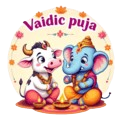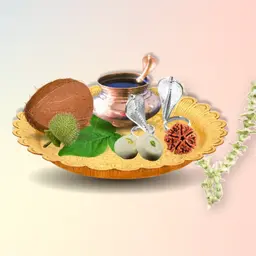
Description
Lord Shiva, the embodiment of compassion and destruction of negativity, is one of the most loved deities in Hinduism. Among the most powerful ways to connect with him is through "Ashtmahabhent" – the offering of eight sacred items that represent total devotion, purity, and inner transformation.
Performed especially during the holy month of Shravan (Sawan), Mondays (Somvars), and on Mahashivratri, this ritual is a symbolic surrender of body, mind, and soul to Mahadev. Temples like Omkareshwar Jyotirlinga, Kashi Vishwanath, and Mahakaleshwar see thousands of devotees perform this sacred offering with deep devotion.
What is Ashtmahabhent?
-
Ashta = Eight
-
Maha = Great
-
Bhent = Offering or gift
Ashtmahabhent refers to eight divine offerings made to Lord Shiva that represent the devotee's complete surrender and spiritual longing.
Each item symbolizes a specific aspect of spiritual growth and purification.
The Eight Offerings in Shiva Ashtmahabhent
1. Jal (Water)
Significance: Cleanses sins and calms the fiery energy of Rudra
Mantra: "Om Gangadharay Namah"
Symbolism: Surrender of ego and purification
2. Bilva Patra (Bael Leaves)
Significance: Represents the trinity – Brahma, Vishnu, Mahesh
Mantra: "Om Bilvapatraya Namah"
Symbolism: Devotion, purity, and balance
3. Dhatura (Datura Fruit/Flower)
Significance: Shiva accepts even poisonous offerings
Mantra: "Om Daturaya Namah"
Symbolism: Offering of negativity, fear, and pain
4. Bhasma (Sacred Ash)
Significance: Symbolizes detachment and truth
Mantra: "Om Bhasma Bhushitaya Namah"
Symbolism: Renunciation of material attachments
5. Sandalwood Paste (Chandan)
Significance: Cools and soothes the deity
Mantra: "Om Chandan Lepitaya Namah"
Symbolism: Peace, prosperity, and divine grace
6. Honey (Madhu)
Significance: Sweetens the offering and pleases the Lord
Mantra: "Om Madhuraya Namah"
Symbolism: Love, humility, and sweetness in life
7. Milk (Doodh)
Significance: Pure, nurturing, and sattvic
Mantra: "Om Ksheerabhishekaya Namah"
Symbolism: Devotion, innocence, and nourishment of the soul
8. Panchamrit (Mix of Milk, Curd, Honey, Sugar, Ghee)
Significance: Divine nectar representing the five elements
Mantra: "Om Panchamritabhishekaya Namah"
Symbolism: Wholeness, unity, and divine completeness
Ritual Process – How to Offer Shiva Ashtmahabhent
Materials Required:
-
Ganga Jal or pure water
-
Bilva leaves (fresh and unbroken)
-
Dhatura fruit or flower
-
Bhasma (vibhuti)
-
Sandalwood paste
-
Pure honey
-
Raw cow milk
-
Panchamrit (prepared fresh)
Step-by-Step Puja:
-
Cleanse yourself with a bath and wear clean clothes.
-
Sit in a peaceful space, ideally facing east or north.
-
Begin with chanting “Om Namah Shivaya” or Mahamrityunjaya Mantra.
-
Offer each item one by one with the appropriate mantra.
-
After the offerings, perform a simple aarti and meditate on Lord Shiva’s form.
When to Offer Ashtmahabhent?
| Day/Event | Significance |
|---|---|
| Shravan Maas | Most powerful month to worship Shiva |
| Somvar (Mondays) | Shiva’s day – best for offering bhents |
| Mahashivratri | Cosmic night of Shiva |
| Pradosh Vrat | Bi-monthly vrat to remove karma |
Spiritual Benefits of Ashtmahabhent
| Offering | Benefit |
|---|---|
| Jal | Purifies thoughts and emotions |
| Bilva | Removes sins and attracts peace |
| Dhatura | Destroys fear, negativity, and ego |
| Bhasma | Awakens detachment and self-realization |
| Chandan | Attracts divine energy and serenity |
| Honey | Sweetens relationships and karma |
| Milk | Nourishes your soul and brings blessings |
| Panchamrit | Harmonizes your body, mind, and spirit |
Ashtmahabhent in Shiva Temples
Many ancient Shiva temples like Omkareshwar, Tryambakeshwar, and Kedarnath host daily and weekly Ashtmahabhent pujas during Shravan and on Shivratris. Devotees walk for miles on Kanwar Yatra to offer these sacred items as a mark of faith and devotion.


